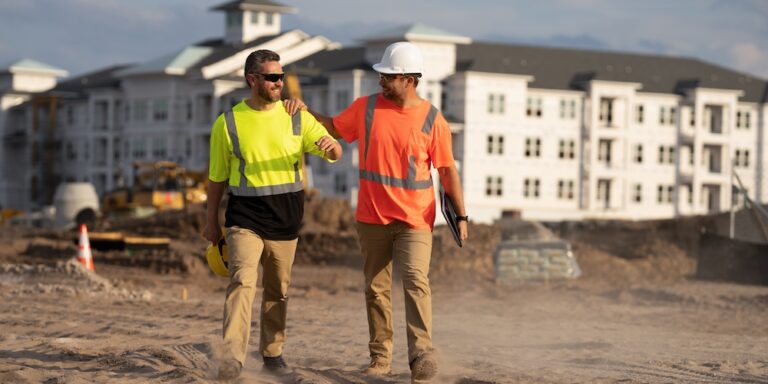— 5 min read
The Importance of Substantial Completion in a Construction Project

Last Updated Sep 10, 2025

Khaled Kalawi
Principal Strategic Product Consultant
Khaled Kalawi is a Principal Strategic Product Consultant at Procore. With extensive experience in construction and engineering, Khaled has held key project management roles at organizations such as Southland Holdings and STRABAG. During his tenure at STRABAG, he held multiple positions including Lead Estimator, Tunnel & Site Engineer, and Tunnel Engineer, demonstrating his expertise in project estimation, tunneling, and site management. He has successfully overseen multimillion-dollar projects, optimized excavation procedures, and implemented innovative solutions that increased efficiency and reduced costs. His early career includes a role as Site Inspector at Khatib & Alami CEC, where he ensured compliance and quality for high-rise residential projects in Beirut. Khaled holds both a bachelor's and master's degree in Civil Engineering from Queen's University. He lives in Toronto.
Last Updated Sep 10, 2025

Owners want to occupy and use their properties as soon as possible — even though every little detail might not be completed. Agreeing to substantial completion lets them do just that. A certificate of substantial completion also lets the contractor get the last payment and collect holdback funds.
Table of contents
Defining Substantial Completion
Substantial completion means the project, or a portion of the project, is fit for its intended use. The owner can then occupy and use the property. There are other important things the date of substantial completion affects:
- The deadline for payments to the general and sub-contractors (final payment and retainage [holdback])
- A contractor’s deadline to file a builder's lien, construction lien (in Ontario), or bond claim
- The expiration date for liability and warranties
How is substantial completion determined?
Construction completion is one aspect of construction project management. In Canada, substantial performance is often defined by provincial laws such as Ontario’s Construction Act or British Columbia’s Builders Lien Act. You can apply substantial completion to a complete project, or to just one part of a project. In both cases, the owner and the contractor sign a certificate of substantial completion.
There will always be minor lingering details to finish up near project completion. At some point, though, these unfinished details don’t prevent the owner from getting some use from the property. Contractors might be waiting on supplies, or for sub-contractors to complete minor portions of their work. The owner and the contractor can agree to substantial completion so both parties can focus their energy and resources on other things.
Certificate of substantial completion
By this point, the owner and the contractor should know each other well enough to be willing, or not, to sign a substantial completion certificate. Construction projects that use contract documents from the Canadian Construction Documents Committee (CCDC) will use contracts as per the varying provinces. For example, there are different types of forms for Ontario and British Columbia.
In this case, the project's architect will inspect the job site and issue the certificate when the site is ready to use.
Owners might resist agreeing to substantial completion if they feel the contractor has not performed well enough. They have concerns about the contractor’s ability or desire to complete the unfinished details. Contractors who have had problems with payments from an owner might not want to sign a certificate of substantial completion. They may fear the owner would drag out payments or worse — not pay. So, there needs to be trust between the owner and contractor if they expect to agree to the terms of substantial completion.
Owners have their reasons for wanting a substantial completion certificate. Contractors and sub-contractors do as well. Here’s an example:
Suppose a contractor is building an apartment building in Toronto, and the apartments are finished. However, they haven’t finished the landscaping or the swimming pool. The owner might decide they want to claim substantial completion for just the apartment portion of the contract so they can rent them out and get revenue flowing.
But for the contractor, that means the rest of their work will happen with tenants, management, and salespeople coming and going. That imposes extra risks. Now, they'll need to invest in extra barricades and maintenance to keep people out of work zones, deal with more traffic in parking lots, and mitigate risks of damage to their and other people’s vehicles. They'll also have increased risks of bodily injury to bystanders, and risk more damage to the work they're doing.
So, substantial completion requires a negotiation between the owner, the owner’s agent, the architect, and the contractor, with each party vying for the best outcomes for themselves.
CCDC Certificate of Substantial Completion Contents
Once the parties agree to the substantial completion definition and terms, they complete a certificate of substantial completion. The top portion names the owner, the owner’s architect, and the contractor. Following that, the owner or architect specifies what is substantially completed. They then list the items the contractor must complete or correct including any costs they will pay for the work and when the work will start and finish.
The document also specifies responsibilities for security, maintenance, heat, utilities, damage to the work, and insurance for any unfinished portions of the project. Under provincial construction laws, this certificate must also be publicly posted to trigger important legal deadlines, such as those for filing builders' liens.
How does a substantial completion form affect all parties?
A certificate of substantial completion has implications for owners and contractors that they might not realize. Legal counsel can give you perspectives on a per-project basis as to the risks and advantages you accept when signing off on substantial completion. Here are the more common ones.
Creates Clear Expectations
Throughout the construction process, there is no substitute for clarity. A well-done substantial completion certificate is very precise in describing the expected outcomes.
Starts Countdown Timer for Other Milestones
Construction completion comes with its own set of milestones that affect everything from warranties to limitation periods. Reaching substantial completion starts a countdown timer for other important milestones, like warranties and limitation periods. Dates are important — they determine your rights if anything is wrong.
Helps Ensure Prompt Payment
For the contractor, substantial completion means they can collect monies owed for the work they’ve done. This includes any holdback amounts that the owner has retained under the terms of the contract and the applicable provincial construction lien laws, eg., Ontario's Construction Act or British Columbia’s Builders Lien Act.
Reduces Contractor Liability
Sometimes, the contractor will have fewer liabilities or project risks to deal with once they have a substantial completion certificate. As pointed out earlier, this depends on the work that’s left to do and whether changes to the site will impose extra expenses or risks. Insurance and bonding coverage are two other factors contractors must consider before agreeing to substantial completion.
Completing a Project
Reaching substantial completion on a construction project can be an exciting time. The owner can use the property. The contractor can collect payment and hold back funds. For both parties, it symbolizes the construction completion of a project or portion of a project, and both of them are free to take their next steps.
Categories:
Written by

Khaled Kalawi
Principal Strategic Product Consultant | Procore
Khaled Kalawi is a Principal Strategic Product Consultant at Procore. With extensive experience in construction and engineering, Khaled has held key project management roles at organizations such as Southland Holdings and STRABAG. During his tenure at STRABAG, he held multiple positions including Lead Estimator, Tunnel & Site Engineer, and Tunnel Engineer, demonstrating his expertise in project estimation, tunneling, and site management. He has successfully overseen multimillion-dollar projects, optimized excavation procedures, and implemented innovative solutions that increased efficiency and reduced costs. His early career includes a role as Site Inspector at Khatib & Alami CEC, where he ensured compliance and quality for high-rise residential projects in Beirut. Khaled holds both a bachelor's and master's degree in Civil Engineering from Queen's University. He lives in Toronto.
View profileExplore more helpful resources

The 5 Key Types of Construction Contracts
There are five common types of construction contracts: lump sum (or fixed price), time and materials (T&M), unit price, guaranteed maximum price (GMP), and cost-plus. Each of these contract types...

Time and Materials (T&M) Contracts in Construction: Guide for Contractors & Project Owners
A time and materials (T&M) contract is a construction agreement where the project owner pays the contractor for all material and labour costs on a project as well as contractor...

Invitation to Tender (ITT) Explained for Construction
An invitation to tender (ITT) is an official document issued by a project owner that targets contractors to solicit tenders for a construction project. The ITT provides all tenderers with...

How Construction Feasibility Studies Guide Building Decisions
There are countless steps taken by stakeholders to ensure the success of a construction project — and many questions that need answering before getting started. Can the project be built...